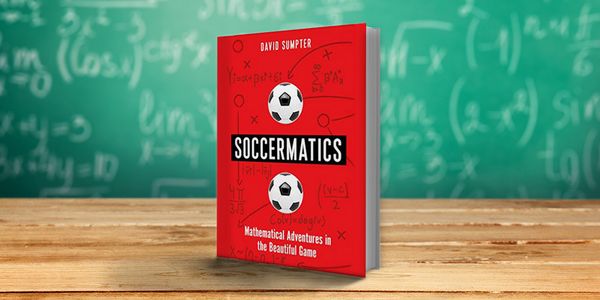Sports and maths are often labelled as separate entities, even though they complement each other in many different ways. This Soccermatics book review explains how David Sumpter uses mathematical modelling to bring the numbers and patterns buried within the sport of soccer to the fore. Read on to find out why “the beautiful game” is more scientific than you think.

Anyone who has visited Betting Resources before will know how a mathematical approach can change the way you think about sports and, more specifically, sports betting. Whether it’s developing an expected goals model or calculating how often you need to beat the closing line, maths is an integral part of being a successful bettor - David Sumpter’s Soccermatics will teach you how mathematical modelling can be applied to soccer.
Complex theories made easy
The application of mathematics to sport, and in particular soccer, has exploded in recent years but very few people have managed to bring the two together in the manner in which they are presented in Soccermatics - you don’t need to be an expert in either field to appreciate how good David Sumpter’s work is.
The author’s personal experiences and passion for the game are integral to his work but it is the fascinating mathematical analogies that make Soccermatics such a unique reading experience. The similarities between slime mould networks and Barcelona’s tiki-taka style of play or the way defender’s limit their opponent’s space and how lionesses hunt their prey are just a few examples that stand out.
Those interested in betting will be drawn to the questions Sumpter asks in his introduction; “How can bookies offer such attractive looking spread bets?” and “Why are the odds so hard to beat?” Although the temptation may be to skip to the final section and find out the detailed answers to those questions, every page of this book is worth the read and offers up something to learn.
The average soccer fan might not think about algorithms, tactical maps and histograms during a match or over the course of the season, but seeing how they can be used to explain events or how the game is played will help broaden your appreciation for the sport of soccer.
Much like David Sumpter’s father, many believe that soccer is simple and straightforward - a game of skill determined by either mistakes or moments of magic. While there is no denying some aspects of soccer are random and down to luck, even Zlatan Ibrahimovic’s majestic 30-yard lobbed bicycle-kick goal against England in 2012 can be explained by mathematics.
If you want to know why the team you support frustrates you by playing a certain way, how important individual players are to a team or how different formations have changed the way soccer is played, Soccermatics will do all of that and more. It even goes as far as explaining how chants create an atmosphere at a soccer match.
Using mathematical models in betting
Several betting themes emerge throughout David Sumpter’s work, but he has also dedicated a chapter to soccer betting and trying to beat the bookmaker. He states early on “the power of mathematical models is that they allow us to extrapolate from what happens in one situation to predict the outcome in other situations” and puts this to the test in the final part of his book.
Readers can even begin to understand the psychological side of betting through the author’s experiences as he analyses common concepts such as favourite-longshot bias and how bettors can be fooled by randomness.
Having discussed more advanced models that can be applied to betting earlier on in the book - like Poisson distribution - Sumpter provides a very simple explanation of how bookmakers work before outlining how he intends to beat them.
Sumpter’s approach isn’t necessarily complex; he simply trials a variety of strategies and ditches each of them once it can be proved that it won’t produce a profit. His Elo rating based strategy, odd-bias, performance indicator and “expert” strategy all produce varying levels of success - if you want to know if he manages to beat the bookmakers, you’ll have to read the book.
Taking your betting education further
A novice bettor can use the last chapter of Soccermatics to help them understand what it takes to make a living from betting. Betting Resources will help further this education with articles about the Wisdom of the Crowd, Green Lumber Fallacy and Kelly Criterion.
Whether it’s developing an expected goals model or calculating how often you need to beat the closing line, maths is an integral part of being a successful bettor.
Readers can even begin to understand the psychological side of betting through the author’s experiences as he analyses common concepts such as favourite-longshot bias and how bettors can be fooled by randomness - both of which and more have been analysed in detail by Joseph Buchdahl for Betting Resources.
The final part of Soccermatics goes a long way to helping bettors understand how odds are formed for markets such as corners betting or betting on bookings, as well as showing how simple probability calculations can be used to find value in betting on the draw in soccer. If, however, you’re looking for the secret ingredient to making a fortune from betting, you’ll have to work a lot harder than reading the last few pages of Soccermatics.
About the author
David Sumpter is Professor of Applied Mathematics at the University of Uppsala, Sweden. His research has shown how mathematics can be applied to anything and everything, and in particular to social behaviour.
Source: pinnacle.com
